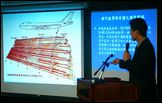|
Cracks, poor maintenance caused CAL crash: report
CONFLICT:
The Aviation Safety Council
said in its report that CAL's poor maintenance
practices ultimately led to the 2002 crash,
but the
airline and the CAA disagree
By Wang Hsiao-wen
STAFF REPORTER
Saturday, Feb 26, 2005

|
An official
with the Aviation Safety Council yesterday
displays the investigation report of the
China Airlines flight CI-611 crash in May
2002 at a press conference yesterday. The
reports said that cracks in the plane's tail
section caused the crash.
PHOTO: CNA |
The Aviation Safety Counsel (ASC) yesterday
published its findings in a report on the China
Airlines plane that broke into pieces over the sea
between Taiwan and Hong Kong in May 2002. The report
blamed cracks in the plane's fuselage, as well as
poor maintenance as the cause of the crash that
killed all 225 passengers on board.
On May 25, 2002, the CAL flight CI-611, a Boeing
747-200 jumbo jet, broke apart and plunged into the
Taiwan Strait 23 nautical miles northeast of Penghu
County shortly after takeoff from CKS International
Airport.
After more than two years of analyzing
information gathered from the plane's flight data
recorder, air traffic control, wreckage distribution
and a reconstructed section of the fuselage, the ASC
concluded that a 180.34cm crack on the fuselage
resulted in the in-flight breakup at the altitude of
10,668m, killing 206 passengers and 19 crew members.
According to the ASC, the fatigue crack in the
aircraft could be dated back to an accident that
took place 25 years ago. On Feb. 7, 1980, the
aircraft suffered damage when its tail touched the
ground while landing in Hong Kong. Although the
damaged plane was shipped back to Taiwan and
underwent
temporary repairs the day after the incident,
permanent repairs conducted by the nation's largest
carrier, China Airlines, were flawed.
"China Airlines did not repair the [damage] in
accordance with Boeing's [structural repair manual].
The damaged skin should have been either trimmed or
removed as the standard procedure required. But the
repairs did not extend sufficiently beyond the
damaged area and thus, did not restore structural
strength," said ASC Chairman Kay Yong at a press
conference yesterday.
The ASC believes that the pre-existing fissures
on scratched surface, and after not having been
properly fixed, deepened and grew to a 180.34cm
crack as a result of pressurization and
de-pressurization during flights.
"A crack measuring 180.34cm in length is long
enough to cause structural separation in the
fuselage. It is the root cause of the in-flight
breakup of the aircraft," said Thomas Wang head of
the ASC's investigation team.
Although the ASC could not confirm exactly when
the fuselage came apart, the Cabinet-level aviation
authority criticized the air carrier for not finding
the damage to the aging aircraft in regular checkups
over the past 25 years.
CAL officials, however, rebuked the ASC's report
and questioned its findings.
"Since the section of the aircraft that is
suspected of causing the crash was not found, the
information is not conclusive enough to determine
the exact cause of the accident," CAL said in a
statement.
"The ASC said that they have found 75 percent of
the aircraft,
but they
actually collected only 50 percent of the damaged
section 46, the key part needed to determine
the cause of the crash," said CAL spokesman Roger
Hen.
While openly disputing the ASC's findings, the
air carrier objected to the claim that maintenance
oversight was also to blame.
"Our checkups are conducted in compliance with
the SRM [structural repair manual]. Boeing stated
clearly that if repairs are done in accordance with
the SRM, there is no need to report it to the
aircraft manufacturer," Hen said.
According to the regulations of Boeing's Repair
Assessment Program, aircraft should have undergone
inspections upon reaching of 22,000 flights. Yet the
accident occurred when the jet completed its
21,398th flight, a few times of landing and take-off
away from the maintenance program's maximum
threshold.
Civil Aeronautics Administration (CAA) slammed
that the ASC's report, accusing the agency of
failing to find the actual cause of the crash.
"How could the ASC jump hastily its conclusions
when half of the [section in question] has yet to be
found?" said CAA director-general Billy Chang.
CAMERAS?
(cctv external and internal)
|